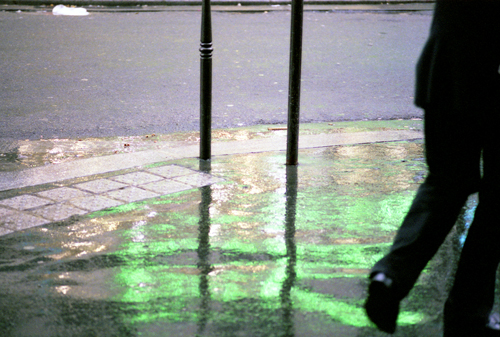 Three years ago Hervé Chandès, the director of the Fondation Cartier, suggested to William Eggleston over dinner that he shoot a series of photographs of Paris. Eggleston thought, "why not, since I am here?" and now the first group of work from this ongoing commission is being shown at the Fondation Cartier until 21 June.
Three years ago Hervé Chandès, the director of the Fondation Cartier, suggested to William Eggleston over dinner that he shoot a series of photographs of Paris. Eggleston thought, "why not, since I am here?" and now the first group of work from this ongoing commission is being shown at the Fondation Cartier until 21 June.
I was curious to see how Eggleston would approach Paris, a city that seems a little too classically beautiful for his eye. The show begins in dramatic fashion with a sort of antechamber in Eggleston's honour, a waiting room before the art begins. A baby grand piano (Eggleston plays and composes) sits in the middle of the blood-red room, a clin d'oeil to his Red Ceiling. Quotes from an interview with Eggleston are printed on the wall, including one in which he claims that he did not change his style for Paris. Based on the first wall of prints, you have to agree.
The first images in the show are abstracts, flattened perspectives of the corner of a film poster or a graffitied wall. They are pure colour and form, and could have been taken in any big city. I was a little worried that Eggleston might have tried too hard to shut Paris out of these photographs, to ensure that its grandeur didn't disrupt his search for the beauty in the mundane. But as the show progresses, you get more of a sense of Paris seeping through the cracks. We even get treated to a couple of glimpses of the Haussmannian architecture, although they are the most commonplace views possible: graffiti on a rooftop, or a busy street corner in the rain lit by sickly green neon, the winter blues etched into the faces of the passers-by.
While Eggleston's style may not have changed for Paris, I think the principles have intensified over the years. Compared to his earlier work these images are more tightly focused on the visual details which catch his eye, cutting out any context almost completely. His 'democratic' approach is unchanged: classical marble scultpure gets gets the same treatment as a garish, hyper-colour merry-go-round. I think the greatest strength here is his mastery of colour, although the saturation of his early dye-transfer prints is replaced with more muted tones.
The prints are accompanied by a series of notebooks and small painting-drawings, abstractions in the brightest possible felt-tip and fluo pens, said to be inspired by Kandinsky. I don't think these would merit an exhibition on their own, and at first they made me think, "please stick to the day job." However, in the final room, they are juxtaposed with his prints, almost as if to say, "this is how you should been reading my photographs": colour and form are everything.
Apparently the work shown here is just the beginning of this commission on Paris. He has said that he hopes to be able to make this a major corpus and one which will be his "crowning achievement." Judging from the work on show here, he just might pull it off.
Rating: Highly recommended